Is Ransom E. Olds The Most Famous Man You Never Heard Of?
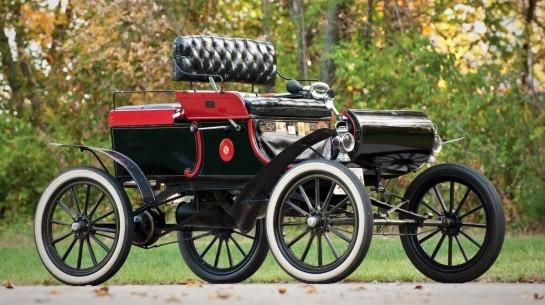
Ransom Olds himself designed the iconic Olds “Curved Dash” horseless carriages of the very early 1900’s. These open cars paved the way for safety, comfort and reliability improvements in U.S. autos.
Story by Jim Hill
Ransom Eli Olds may be the most famous man you never heard of. And even though you may not know of Ransom Olds and his legacy, you may have had considerably more contact with his handiwork and namesake than you thought. Half a century later, drag racers found a new source for horsepower coming from the auto company that Ransom Olds founded.
That auto manufacturer, eventually named Oldsmobile, engineered and mass produced the famed 1949 Oldsmobile 303 Rocket V-8 engine. This was the first mass-produced overhead-valve (OHV) design and would become an entire family of powerful, popular V-8 engines. That first OHV Olds engine forced the U.S. auto industry to abandon its previous flathead designs. By the early 50’s, OHV V-8 engines were available from all GM Divisions. Quickly following GM’s lead, Ford, Chrysler, Studebaker, Packard and American Motors all introduced OHV V-8 engines. On its heels came even more advanced designs with the famous 265 V-8 offered in 1955 Chevrolets.
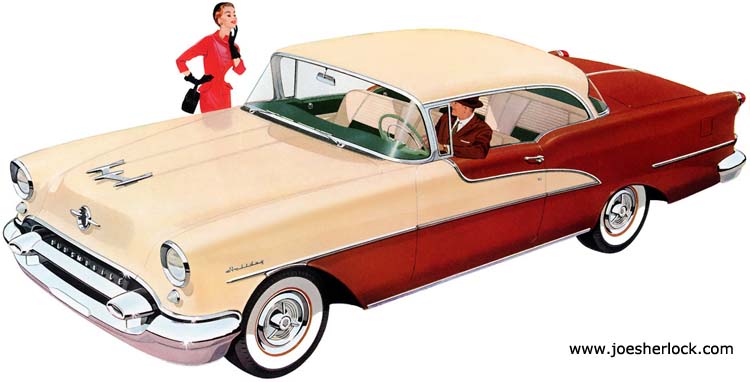
Detroit’s finest illustrators created memorable auto art for magazine ads. Here a 1955 Oldsmobile Holiday shows off its Cream and Red splendor in an ad. 55-56-57 GM cars from all divisions reflected basic styling such as windshield shape, A-Pillar location, and of course, the graceful chrome “Hood Bird”.
Early hot rodders and especially drag racers quickly recognized the power potential of the modified Olds OHV design. Both Oldsmobile and Cadillac OHV engines were favored during those early years, easily out-powering even the most highly modified Ford flatheads.
Olds and Cadillac engines were especially popular for engine swaps. Pre-war Fords were a favorite for replacing the flathead Ford V-8’s. These cars were repurposed by skilled mechanics and car builders in The Carolinas, Virginia and North Georgia, reemerging from their shops as fast moonshine haulers. They were driven by men who became highly skilled at outrunning federal and state revenue agents. Many of NASCAR’s legendary early drivers came from their ranks. Just as many early drag racers were known to have driven these cleverly disguised, souped-up cars carrying “white liquor” in jars, gallon jugs or in bulk tanks.
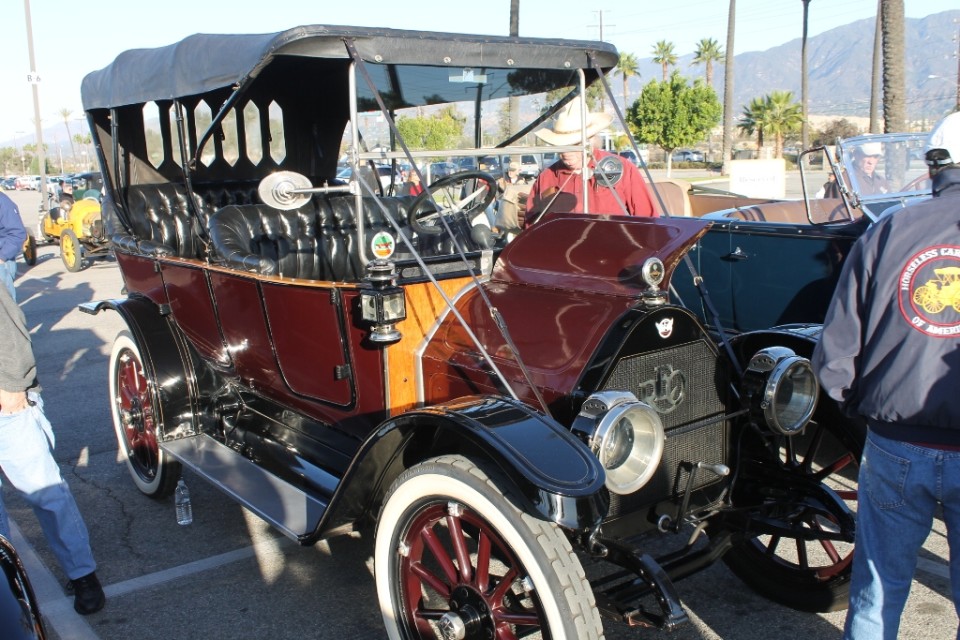
By the early ‘teens Olds had adopted the name REO for his autos after a lawsuit forced him to use his initials as a trademark. This beautifully restored REO touring car was top of the line in 1915.
The mid 1950’s Olds engines were sturdy, powerful V-8’s that responded favorably to commonly applied hot rod modifications. Hot-rodded Olds V-8’s were popular engines for all sorts of hot rods including dragsters and Supercharged Gassers.
In 1959, at Detroit Dragway, California driver Leonard Harris won Top Eliminator at the NHRA Nationals powered by a 480 CID blown Olds. Another young SoCal racer, Gene Adams, tuned for his Albertson Olds team. Stone-Woods & Cook’s A/Gas Supercharged Willys became known as one of that class’ fastest, running blown Olds engines for several years. Other Olds fans included Hugh Tucker’s AA/Street Roadster, and Gene Adams’ fastback ’50 Olds sedan.
By the early part of the 20th Century, back in Lansing, Ransom Olds got the auto industry ball rolling, bestowing his name upon his most famous legacy, Oldsmobile. Later, cars and trucks were made by REO, Ransom Olds’ initialized acronym. ‘Ol Ransom even loaned his name to the 70’s-80’s rock band, “REO Speedwagon”. That name was taken from an Olds designed lightweight truck, said to be the industry’s first pick-up!
In his later life, Olds became equally famous for his real estate ventures on both the east and west coasts of 1920’s Florida. The city of Oldsmar remains as another Ransom E. Olds legacy. Oldsmar’s city boundaries are located on the west coast of Florida, just north of Tampa.
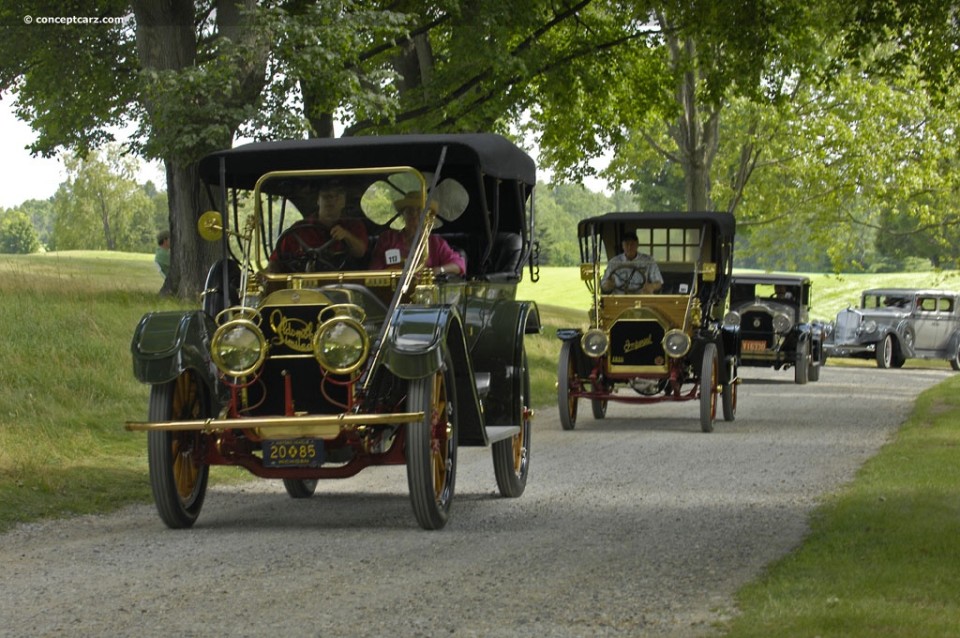
This million-dollar line up of restored antiques is led by an impressive early Olds touring car. This historical line-up was out enjoying a drive on a warm Michigan summer afternoon.
An automotive industry pioneer and a visionary in many other endeavors, in 1913 Olds purchased a tract of property totaling 37,547 acres. He envisioned building a city that would serve as an American Utopia. Olds’ idea was a city planned and built to be resident-friendly. Families would exist in a community that provided everything needed, including employment, and all within a few minutes of their front door. The onset of the Great Depression prevented his dream from becoming fully realized, but the city that remained survived and exists yet today. Oldsmar is home to Tampa Downs, a large thoroughbred horse racing facility.
Oldsmar even has a deep drag racing connection. Twin-City Dragway was a 60’s drag strip once operated by Tampa native Leroy Gonzales. Later, Don Garlits held Twin-City’s lease and used the track for testing his various Swamp Rat dragsters. It was at Twin-City Dragway, in early 1971, that Garlits, Tommy “TC” Lemons and Connie Swingle (now both deceased) worked out the handling issues of his first 1971 rear-engine car.
Ransom Olds himself had strong ties to auto racing, in its earliest days. In 1902 Olds drove a stripped-down, crablike creation on the hard-packed sands between Daytona and Ormond Beach, Florida. Olds intended to convince the still skeptical American public that the automobile was here to stay, and the horse on its way out.

Ransom Eli Olds not only designed and built his earliest cars, he drove them too. In 1902 Olds, who also experimented with steam powered vehicles, braved the sands between Daytona and Ormond Beach to show the public his “car” was capable of sending the horse out to pasture.
Born in 1864, in Geneva, Ohio, Olds passed in 1950 at age 86. In his lifetime he saw most of his dreams and vision realized. He also witnessed and was a major player in the birth and growth of the American auto industry, the cornerstone of U.S. industry and labor.

Driven by Doug Cook, the Stone-Woods-Cook ’41 Willys ran a big-inch Olds with 6-71 blower and Hilborn injection for low nine-second runs.

High Tucker’s ’29 Chevy bodied AA/Street Roadster famously used blown Oldsmobile power with a B&M Hydro-Stick automatic trans. Note Olds’ shaft-mounted valve train. The “street roadster” ran high nine’s at 130+ mph.
When he was a boy the Olds family moved from Ohio to Lansing, Michigan, where Ransom worked in his father P.F. Olds’ blacksmith and machine shop. The shop specialized in repairing and building steam engines, the mainstay of industry, marine, and rail transportation. Young Ransom soon became a skilled machinist, pattern maker and mechanic. Although he never completed high school, Olds did take courses at Lansing Business College. These studies provided skills that would greatly benefit him in later life.
A trip to the Chicago World’s Fair in 1893 excited Olds to create his own design for an internal combustion engine. By 1896 Ransom Olds had built his first internal combustion engine, and applied for patents. He formed the Olds Motor Vehicle Company in 1897. Underfunded, it sputtered before becoming Olds Motor Works and acquiring a major investor, Frederick Smith. Smith insisted on moving the firm to Detroit, the emerging capitol for the fledgling U.S. auto industry.

Ransom Olds’ “Speed Wagon” is said to be the auto industry’s first pick-up truck, a stripped-down, basic hauling utility vehicle. Pick-up fans should note that very generous, “long bed” cargo box!
Olds himself designed the famed “curved dash” body of the Olds motor car. It sold for $650, a modestly mid-priced sum in 1901. By 1905 production had reached over 5,000 cars, but after a disagreement with investor Frederic Smith, Olds had sold his stock and left in 1904.
By 1905 Ransom Olds was back in the auto business, this time producing the REO between 1905 and 1909. The name REO came after a lawsuit claimed his new business name, R.E. Olds Company, infringed on trademark rights of Detroit Olds Motor Works. Ransom changed the name to his initials, REO. Once again Olds grew disenchanted with investors and left that company. In the meantime, William Durant’s General Motors bought Olds Motor Works. Olds spent his next two decades mostly away from the auto industry. Instead, he was heavily involved in real estate development activities.
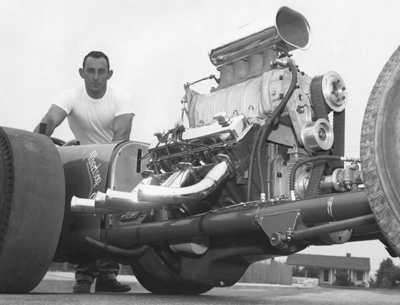
Leonard Harris drove the Gene Adams tuned Albertson Olds Special to Top Eliminator honors at ’59 NHRA Nationals, Detroit. The stroker crank equipped, 480 CID blown Olds was one of the most powerful. Harris died in a 1960 crash and Tom McEwen took over. McEwen later became “The Mongoose”, opposing Don “The Snake” Prudhomme as Mattel Hot Wheels icons.

Gene Adams ruled SoCal drag strips in the early 50’s with this supercharged, ’49 Olds fastback. Adams was known as an Olds engine wizard and later as the “go-to” man at Hilborn, for all fuel injection systems.
One of those projects involved Daytona Beach, where Olds constructed a four-story resort hotel that overlooked the scenic Halifax River. He wanted a hotel with luxury amenities available for his own and other wealthy travelers headed south on Henry Flagler’s Florida East Coast Railway. The hotel was built just east of the FEC main line tracks and Daytona Beach depot. That structure remains today, located south of International Speedway Boulevard, U.S. 92, and U.S. 1, or Ridgewood Avenue. “Olds Hall” is today a retirement home, but its restored beauty still reflects the splendor of Ransom E. Olds’ early 20th Century real estate venture.
Ransom Olds’ REO continued to build trucks through WW-II until being sold, twice, before closing down in the 1950’s. REO medium and heavy duty trucks were known for their rugged construction and reliable operation. REO’s were a particular favorite of municipal truck fleet purchasers looking for long-life service and low maintenance.
While Ransom E. Olds never seriously challenged the manufacturing and marketing prowess of Henry Ford, he did initiate several notable concepts that remain industry mainstays. Olds’ most significant contribution was the assembly line for manufacturing automobiles. Henry Ford himself credited Olds with creating this manufacturing breakthrough. Ford also took Olds’ idea one step further with the moving assembly line. Rather than workers moving to parts sources, Ford’s moving line brought the parts directly to each worker’s station. This not only hastened the assembly process, it reduced costs. The rock-bottom pricing of the Model-T Ford created the tidal wave of sales of Model-T and later Model-A cars and trucks.
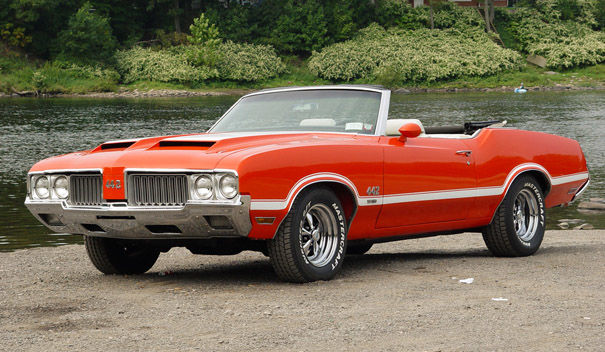
Another iconic Oldsmobile was the 60’s and 70’s 4-4-2 series. Here a 1970 4-4-2 convertible with 455 CID Olds power, cold-air induction hood and Cragar S/S wheels shows its stuff. Hurst created a stylized 4-4-2 known as The Hurst Olds, often seen at major races carrying Miss Hurst, Linda Vaughn.
Ransom Olds died in August 1950, in his Lansing home. Ironically, his wife of 61 years, Metta Ursula Woodward herself fell ill during Olds’ funeral, and passed away just three weeks later! Olds’ Lansing home, which he built in the early 1900’s, was demolished in 1971. The unstoppable, forward march of progress claimed the Olds home for the I-496 highway project. Olds’ name and many years as a resident plus the widespread Oldsmobile Division’s influence are present in many locations in Lansing, Michigan.
Ransom E. Olds’ active auto industry legacy lasted until GM killed the iconic Oldsmiobile brand in 2004. This action was part of its financial restructuring, U.S. Government “buy-out” and consolidation. Today a large contingent of still loyal Olds fans remains. Such loyalty continues to remind us of just how important Ransom Eli Olds was to the auto industry, and to early drag racers as a favored power source.
Ransom E.Olds was said to have an easy sense of humor and a ready laugh. That leaves one to wonder what he would say about a top-billed, highly-amplified rock act adopting the name of his famous pick-up, the REO Speedwagon!

